
Bamboo Descriptions
The description for each species or cultivar includes the scientific name, the maximum height (in feet), maximum culm diameter (in inches), growth form (clumping or running) and a cold hardiness rating that indicate the minimum temperature at which rhizomes, culms, and leaves will survive. Bamboos will survive temperatures lower than those given but some leaves will drop and canes will die.
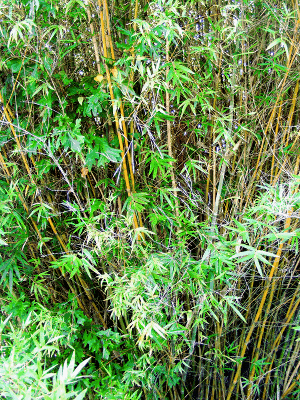 Bambusa multiplex
— 35' max. ht., 1 ½" culm dia., clumping, cold hardiness 12 °F.
Bambusa multiplex
— 35' max. ht., 1 ½" culm dia., clumping, cold hardiness 12 °F.
This bamboo and cv. Silverstripe (above) are the best non -invasive bamboos
to use for tall screens and hedges. It may be trimmed to a desired height
without damaging the plant. This plant and the cultivar Silverstripe make
excellent windbreaks. This species including all of the cultivars listed
below grows well in middle and south Georgia and suffers some culm damage
in cold winters but always comes back from the rhizome. Reports of the hardiness
of this species in Atlanta vary but it can probably be grown from the north
end of I -285 and most points south. If the temperatures drop to the single
digits or low teens you will probably see some cold damage but it usually
recovers. The northern Atlanta suburbs and mountains are too cold unless
you have a warm microclimate. The culms bend out toward the light as the
plant grows and this creates a vase shaped plant. The size of this species
and the cultivars listed here can be manipulated by irrigation. Dry conditions
result in smaller plants and lots of water create larger plants.
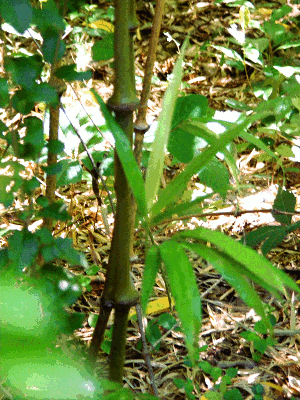 Chimonobambusa (Qiongzhuea) tumidissinoda
— 20' max. ht., 1 ¼ " culm dia., running cold hardiness 10 °F.
Chimonobambusa (Qiongzhuea) tumidissinoda
— 20' max. ht., 1 ¼ " culm dia., running cold hardiness 10 °F.
This bamboo is used to make walking sticks in China. It is unusual because
of the swollen nodes, arching culms and delicate, feathery foliage. It can
be used as a dense screen or the low branches can be pruned to show off the
interesting culms. Will grow outdoors from Atlanta south and does best with
shade.
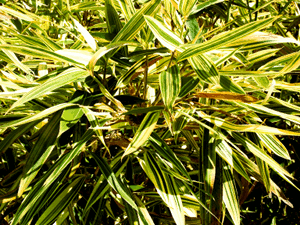 Hibanobambusa tranquilans
— cv. Shiroshima, 16' max. ht., 1 ¼" culm dia., running, cold hardiness 0 °F.
Hibanobambusa tranquilans
— cv. Shiroshima, 16' max. ht., 1 ¼" culm dia., running, cold hardiness 0 °F.
This species is native to Japan and is thought to be a natural hybrid between
Sasa veitchii and Phyllostachys nigra 'Henon'. The cultivar 'Shiroshima'
has cream and green variegated leaves. This bamboo is notable for its moderate
size, stable variegation and ability to grow in the shade or sun. Maximum
size of our plants so far is 8 -10' in the sun with some afternoon shade.
 Indocalamus sp. "solidus", 10' max. ht., ½" culm dia.,
running, cold hardiness 0 °F.
Indocalamus sp. "solidus", 10' max. ht., ½" culm dia.,
running, cold hardiness 0 °F.
The culms are solid and the leaves can be as long as 8 to 10 inches.
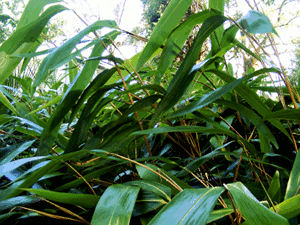 Indocalamus (Sasa) tessellatus, 12' max. ht., ½" culm dia., running,
cold hardiness -5 °F.
Indocalamus (Sasa) tessellatus, 12' max. ht., ½" culm dia., running,
cold hardiness -5 °F.
The ultimate height can vary from 3 -12' and depends on the amount of
shade and whether moisture is limited. This bamboo has the largest leaves
(24" long, 4" wide) of any bamboo in cultivation. This bamboo grows
well in pots and requires shade for best performance. The leaves hang down
and this plant would look good on a slope.
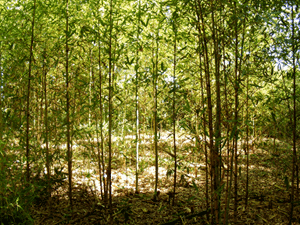 Phyllostachys aurea cv. Koi , 27' max. ht., 1 5/8" culm dia., running,
cold hardiness 5 °F.
Phyllostachys aurea cv. Koi , 27' max. ht., 1 5/8" culm dia., running,
cold hardiness 5 °F.
The culms turn from green to yellow after the first 6 months, but the culm
grooves remain green. The color pattern is identical to P. bambusoides 'Castillon' but
this plant has the upright form, vigorous growth, shortened internodes and
low branching typical of P.aurea. This is a wonderful yellow bamboo for zones
7, 8, and 9 that is not widely grown in the trade.
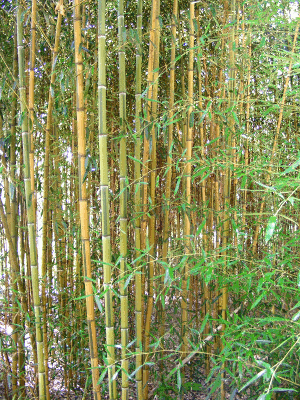 Phyllostachys aureosulcata f. spectabilis, 26' max. ht., 1 ½" culm
dia., running, cold hardiness -10 °F.
Phyllostachys aureosulcata f. spectabilis, 26' max. ht., 1 ½" culm
dia., running, cold hardiness -10 °F.
The yellow culms with green grooves are the opposite of the typical form.
This plant is a striking ornamental that is suitable for colder climates
but also does well here in central Georgia. It branches well on the lower
part of the culm and is a good screening bamboo.
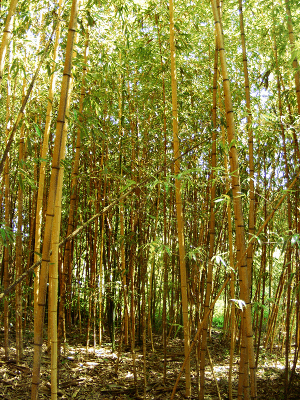 Phyllostachys bambusoides cv. Allgold, 35' max. ht., 2" culm dia.,
running, cold hardiness 5 °F.
Phyllostachys bambusoides cv. Allgold, 35' max. ht., 2" culm dia.,
running, cold hardiness 5 °F.
Very similar to P. bambusoides cv. Castillon but the culms are entirely golden
yellow except for an occasional thin green stripe. This form should make
an extremely attractive garden ornamental.
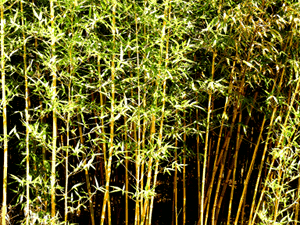 Phyllostachys bambusoides cv. Castillon, 30' max. ht., 2" culm dia.,
running, cold hardiness 0 °F.
Phyllostachys bambusoides cv. Castillon, 30' max. ht., 2" culm dia.,
running, cold hardiness 0 °F.
This bamboo differs from the typical form by having brilliant yellow culms
with green grooves and occasional cream colored stripes in the leaves. This
bamboo was popular and somewhat widely distributed in the U.S. until it flowered
and died out in the 1970's. It makes a striking ornamental plant and appears
to be a vigorous grower. It and cultivar Allgold are susceptible to thread
scale, rust and noxious mealybug and the foliage on older culms can look
bad if these pests are not managed.
 Phyllostachys bambusoides cv. Slender Crookstem, 48' max. ht., 3" culm
dia., running, cold hardiness 0 °F.
Phyllostachys bambusoides cv. Slender Crookstem, 48' max. ht., 3" culm
dia., running, cold hardiness 0 °F.
This cultivar. is distinguished by having one or more curved (not as abrupt
as a zigzag pattern) internodes occurring near the base of the culm in a
high percentage of culms in a clump. Most of the culms are also more slender
in relation to their height than those of the typical form of the species.
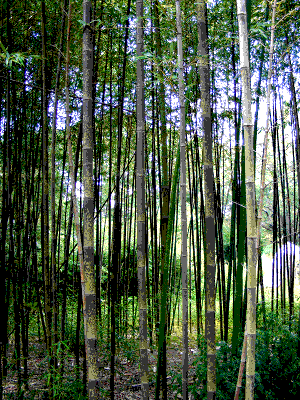 Phyllostachys bambusoides tanakae — 48' max. ht.?, 3" culm dia.?, running,
cold hardiness 0 °F.
Phyllostachys bambusoides tanakae — 48' max. ht.?, 3" culm dia.?, running,
cold hardiness 0 °F.
This cultivar has culms marked with elliptical purplish-brown spots. The
spots increase in size and number as the culms age. It is a vigorous and
erect like the species and has an open appearance in mature groves. This
bamboo makes a striking specimen planting.
 Phyllostachys dulcis — (Sweetshoot bamboo), 40' max. ht., 2 ¾" culm
dia., running, cold hardiness -8 °F.
Phyllostachys dulcis — (Sweetshoot bamboo), 40' max. ht., 2 ¾" culm
dia., running, cold hardiness -8 °F.
Referred to by Frank N. Meyer as the "edible bamboo of central China".
Robert Young reported that it had the best tasting shoots when raw. The plant
is vigorous, fast growing and shoots early. The culms bend toward the light
resulting in curved culms and a vase shaped grove. This is the best suggestion
when someone wants a bamboo for edible shoots. This bamboo sizes up quickly
and grows well in zones 6, 7, and 8.
 Phyllostachys edulis (P. heterocycla pubescens) (Moso bamboo), 75' max.
ht., 7" culm dia., running, cold hardiness 0 °F.
Phyllostachys edulis (P. heterocycla pubescens) (Moso bamboo), 75' max.
ht., 7" culm dia., running, cold hardiness 0 °F.
Culms have dense hairs (pubescence) hence the name. This is the largest and
most sought after of the giant running bamboos but is difficult to propagate.
Plants are easily identified because young culms are hairy to the touch.
The “landscape presence " of this species is clearly superior
to P. bambusoides, P. nigra 'Henon', or P. vivax but it was rarely
seen because it was not widely available in the nursery trade. Seedling plants
are now more common because of the availability of seed of this species.
 Phyllostachys nidularia, 33' max. ht., 1 ½" culm dia., running,
cold hardiness 0 °F.
Phyllostachys nidularia, 33' max. ht., 1 ½" culm dia., running,
cold hardiness 0 °F.
It is fast growing and produces many culms forming a thick screen. The small
strong culms make good plant stakes but do not split well. The nodes on this
species are large and prominent and distinguish it from other Phyllostachys
species. The shoots of this bamboo are popular in the markets of China.
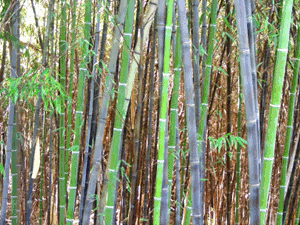 Phyllostachys nigra (Black bamboo), 30' max. ht., 2" culm dia., running,
cold hardiness 0 °F.
Phyllostachys nigra (Black bamboo), 30' max. ht., 2" culm dia., running,
cold hardiness 0 °F.
This species is a very desirable garden ornamental. The emerging culms are
green but gradually become almost completely black within 6 -24 months. Mature
rhizomes are also black making this bamboo easy to distinguish in the field.
Also used in the orient for cabinetry work. This plant is the undisputed “queen " of
hardy ornamental bamboo. This species is grown in the trade but is almost
always in short supply. It is also well known to landscape designers and
contractors and is one of our most requested plants.
 Phyllostachys nigra cv. Bory, 50' max. ht., 3" culm dia., running,
cold hardiness 0 °F.
Phyllostachys nigra cv. Bory, 50' max. ht., 3" culm dia., running,
cold hardiness 0 °F.
Young culms are green developing brown and purple spots with age. Plants
are larger and more vigorous than the common form of P. nigra. This plant
can be used in place of P. nigra 'Henon' and the brown spots
add additional interest. It is definitely underused in the landscape.
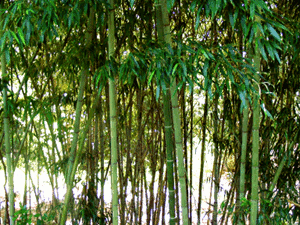 Phyllostachys nigra cv. Henon, 65' max. ht., 4 ½" culm dia., running,
cold hardiness -4 °F.
Phyllostachys nigra cv. Henon, 65' max. ht., 4 ½" culm dia., running,
cold hardiness -4 °F.
This is a much larger cv. of the common black bamboo whose culms do not turn
black. It has dense dark green delicate foliage and a gray waxy film on many
culms. This bamboo is a striking ornamental that also has strong culms that
are good for construction purposes. This is plant is well known and widely
used for specimen plantings including some high profile installations. This
bamboo has a distinctive “look " but it could be said that it
is overused because other species are not readily available.
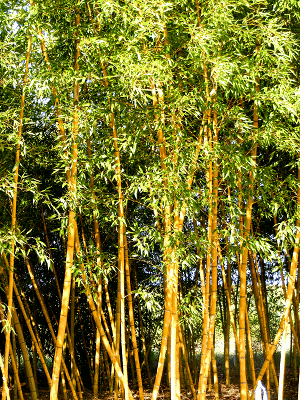 Phyllostachys viridis cv. Robert Young, 45' max. ht., 3" culm dia.,
running, cold hardiness -5 °F.
Phyllostachys viridis cv. Robert Young, 45' max. ht., 3" culm dia.,
running, cold hardiness -5 °F.
This is a lovely ornamental form of P. viridis with culms that are yellow-green
when young but turn golden yellow a few months after emergence. Some culms
have a few narrow, vertical, green stripes on the lower internodes. This
is an attractive plant that is moderately available in the trade but always
sells well. The large yellow culms make an impact in the landscape.
 Phyllostachys vivax, 70' max. ht., 6" culm dia., running, cold hardiness
-5 °F.
Phyllostachys vivax, 70' max. ht., 6" culm dia., running, cold hardiness
-5 °F.
This is an excellent timber bamboo for ornamental use. This species has been
observed to out grow P. bambusoides when planted side by side but has thinner
culm walls than that species and the culms are slightly zigzag. This bamboo
may also have greater cold hardiness than some clones of P. bambusoides.
This bamboo easily reaches culm diameters of 5" in central Georgia and
probably grows even larger. This is the best timber bamboo to try in cold
climates but a mature grove with 5 " culms is growing in Ocala, Florida.
The leaves of this species are larger than P. bambusoides and the foliage
has a denser appearance.
 Phyllostachys vivax aureocaulis ?' max. ht., ?" culm dia., running,
cold hardiness -5 °F.
Phyllostachys vivax aureocaulis ?' max. ht., ?" culm dia., running,
cold hardiness -5 °F.
This is a yellow form of P. vivax with culm coloration similar to P. bambusoides 'Allgold'.
Our grove planted from a single 2 G plant in 2000 has 3 ", 35'+
culms which attract the eye of all who see the grove. If you want an outstanding
LARGE specimen plant for your landscape, this is the one to use.
 Pleioblastus distichus Mini, 2' max. ht., 1/8" culm dia., running,
cold hardiness 10 °F.
Pleioblastus distichus Mini, 2' max. ht., 1/8" culm dia., running,
cold hardiness 10 °F.
Similar in appearance to P. pygmaeus but has tiny leaves that are often only
1" long and ¼" wide. This bamboo is a good ground cover for shady
locations and is a good container plant. It can be very invasive, especially
in cooler climates.
 Pseudosasa japonica (Arrow bamboo), 18' max. ht., ¾" culm dia., running,
cold hardiness 0 °F.
Pseudosasa japonica (Arrow bamboo), 18' max. ht., ¾" culm dia., running,
cold hardiness 0 °F.
Common ornamental in U.S. and easily pruned into hedge form. Small rhizomes
are easier to remove than larger running bamboo. Among U.S. bamboo this one
is the favored food of visiting panda bears. This is a great choice for shady
areas or interior use where dwarf bamboo is not large enough.
 Pseudosasa japonica tsutsumiana 10' max. ht., ¾" culm dia., running,
cold hardiness 0 °F.
Pseudosasa japonica tsutsumiana 10' max. ht., ¾" culm dia., running,
cold hardiness 0 °F.
This is an attractive ornamental that prefers partial shade. Green Onion
Bamboo got its name because some culms are swollen at the base like a green
onion. Plants growing in full sun may not get as tall. The rhizomes are also
swollen and shortened compared to the species and as a result it is not as
invasive as P. japonica. This is the best choice in situations where clump
bamboo won't grow and clients are afraid of running bamboo.
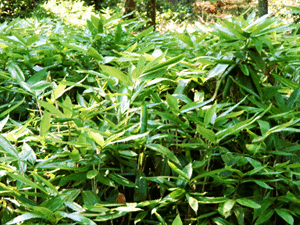 Sasa palmata 7' max. ht., ½" culm dia., running, cold hardiness 0 °F.
Sasa palmata 7' max. ht., ½" culm dia., running, cold hardiness 0 °F.
This plant needs some shade for best results. In middle Georgia it will be
2 -4' tall when grown in full sun but can reach 7' under shade. It has long
wide leaves and is an attractive ornamental.
 Sasa veitchii 5' max. ht., 1/3 " culm dia., running, cold hardiness
0 °F. This small bamboo produces dark green leaves to turn white along
the margins in winter, seen in all Sasas, is pronounced. This, along with
large leaves on short plants gives a unique and striking appearance.
Sasa veitchii 5' max. ht., 1/3 " culm dia., running, cold hardiness
0 °F. This small bamboo produces dark green leaves to turn white along
the margins in winter, seen in all Sasas, is pronounced. This, along with
large leaves on short plants gives a unique and striking appearance.
 Sasaella masamuneana albostriata, 6' max. ht., ¼" culm dia., running,
cold hardiness 0 °F.
Sasaella masamuneana albostriata, 6' max. ht., ¼" culm dia., running,
cold hardiness 0 °F.
This is an attractive bamboo with white striped leaves. Does well in moderate
shade.
 Semiarundinaria fastuosa, 30' max. ht., 1 ½ " culm dia.,
running, cold hardiness -5 °F. This is an erect, elegant bamboo with straight
culms and short branches. The green culms can turn from green to purplish
brown with age or exposure to sun. S. fastuosa has performed well in dry
harsh growing conditions in central Texas.
Semiarundinaria fastuosa, 30' max. ht., 1 ½ " culm dia.,
running, cold hardiness -5 °F. This is an erect, elegant bamboo with straight
culms and short branches. The green culms can turn from green to purplish
brown with age or exposure to sun. S. fastuosa has performed well in dry
harsh growing conditions in central Texas.
Shibataea kumasaca, 6' max. ht., 1/8" culm dia., running, cold hardiness
0 °F.
This is a small and distinctive ornamental bamboo. The branches are short,
the leaves broad and ovate -lance shaped, sharp pointed, and are whorled around
the slender culm. Prefers some shade and makes a good groundcover. The leaves
will tip -burn when grown in alkaline soils.
 Sinobambusa tootsik albostriata, 30' max. ht., 1 ½' culm
dia., running, cold hardiness 10 °F. This is a vigorous growing runner
with straight, erect culms and boldly variegated green and white foliage.
This running bamboo grows well in warmer parts of the southeast but will
survive as far north as Birmingham and Atlanta. It can be used as a screening
bamboo or as a striking specimen plant.
Sinobambusa tootsik albostriata, 30' max. ht., 1 ½' culm
dia., running, cold hardiness 10 °F. This is a vigorous growing runner
with straight, erect culms and boldly variegated green and white foliage.
This running bamboo grows well in warmer parts of the southeast but will
survive as far north as Birmingham and Atlanta. It can be used as a screening
bamboo or as a striking specimen plant.
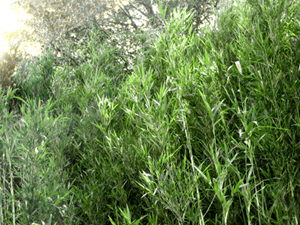 Yushania anceps Pitt White, 25' max. ht., ½ " culm dia.,
long necked open clumper, cold hardiness 0 °F.
Yushania anceps Pitt White, 25' max. ht., ½ " culm dia.,
long necked open clumper, cold hardiness 0 °F.
This bamboo spreads out like a running bamboo but grows slowly. It forms
small clumps of culms within the grove like Arrow bamboo or Simon bamboo.
It has handled our heat quite well and should do well in the piedmont areas
of the southeast. The culms are upright and the leaves long and narrow. This
bamboo grows well in sun or shade.
<
Copyright © 2012 Georgia Bamboo | Designed By: Easy Web Design Professionals